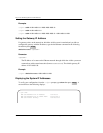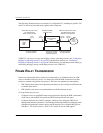
ATM
22 Avidia System Configuration and Management User Manual
ATM Traffic Management
ATM connections are assigned a traffic profile, which specifies the Quality of Service (QoS)
that will be available to the connection. Avidia traffic management features ensure that each
connection is able to maintain its specified QoS.
ATM Traffic Management Features
The following traffic management features are supported by the Avidia system:
• Connection Admission Control (CAC) allocates resources for connection requests.
• Usage Parameter Control (UPC) functions, compatible with ATM User Network Interface
Specification 3.1, monitor ATM traffic and discard non-conforming cells.
• CBR, UBR, rt-VBR and nrt-VBR service types are supported.
• Queuing is managed on a per-VC and per-QoS basis.
• Statistics are collected for all established connections.
In addition, the following sections list the traffic management capabilities and limitations
specific to OC3 and ADSL cards.
OC3 Card. The following are traffic management features for the OC3 card:
• Each card supports up to 4096 total connections (VPs and VCs combined).
• Queues are created by CAC for each individual VP, with a maximum of 992 connections
per VP.
ADSL Card. The following are traffic management features for the ADSL card:
• Each card supports up to 512 total connections (VPs and VCs combined).
• Queues are created by CAC for each individual VP, with a maximum of 256 connections
per VP.
SDSL Cell Card. The following are traffic management features for the SDSL cell-based
card:
• Each card supports up to 512 total connections (VPs and VCs combined).
• Queues are created by CAC for each individual VP, with a maximum of 256 connections
per VP.


















